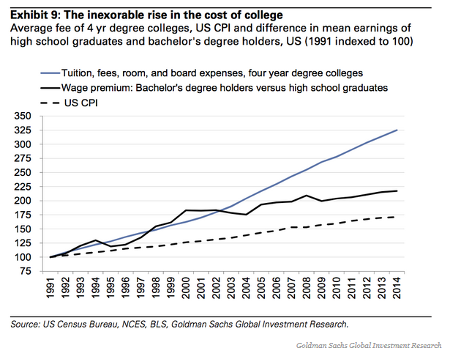It is never a straight line…
Looking at the weekly numbers, it looked like a most boring week for Equities and Fixed Income; of course the daily details show a completely different story. But while the major stock and bond markets showed little changes for U.S.-based investors, the currency and commodity markets made significant moves. Mario Draghi of the ECB backed off his aggressiveness to fight economic weakness sending the oversold euro up 3% on Thursday. And, while oil should have retreated on the weak U.S. dollar, the commodity traded back to its August lows as investors feared Friday’s OPEC meeting. By the weekend, the Energy sellers were correct as OPEC reached no consensus to reign in production. So now as we glide into next week’s FOMC meeting and given the continued job gains in the U.S. economy, the Fed looks like it is still on track to raise interest rates. Of course, it won’t be a straight line of certainty given the ongoing disruption in the Energy and Commodity industries, as well as the continued broken High Yield Bond markets. If you are looking to try and catch any of the current falling knives in Equities or ETFs, I would caution you to look for a bounce in the respective industry’s credit markets first. The credit markets are usually much larger than the equity markets so they can often point you in the right direction.
Last week’s Major ETF performance is a strange one. Small Caps are not following the December seasonal roadmap…
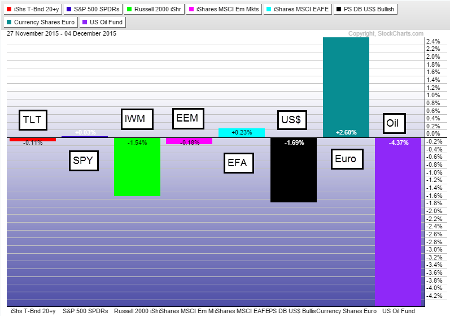
Investors betting on the euro vs. U.S. dollar last week found out what it feels like to be in an overly crowded trade…
A bout of fresh measures from the ECB on Thursday, including a cut in its deposit rate, triggered a sharp reaction in bond, currency and stock markets.
The scale of the new stimulus measures from the ECB disappointed some investors, who sent the euro up 3 per cent against the U.S. dollar in one of its sharpest-ever moves, while European and U.S. stocks slumped.
However, Mr Dalio said in a statement on Friday that expectations for an ultra-dovish move from the ECB had been ratcheted up so high, that the central bank was almost bound to spark volatility regardless of its actions.
“There is a saying in the markets to ‘buy on the rumor and sell on the news’. That’s what happened,” Mr Dalio said, adding that “the market was very short the euro and very over-weight European equities, so it was primed for a correction.”
One would think that given the trend in oil prices, that a short bet into the meeting would have also been a crowded trade. But little did we know just how bad OPEC disagreements were…
The OPEC cartel is to continue flooding the world with crude oil despite a chronic glut and the desperate plight of its own members, demanding that Russia, Kazakhstan and other producers join forces before there can be output cuts.
Brent prices tumbled almost $2 a barrel to $42.90 as traders tried to make sense of the fractious OPEC gathering in Vienna, which ended with no production target and no guidance on policy. It reeked of paralysis.
Prices are poised to test lows last seen at the depths of the financial crisis in early 2009. The shares of oil companies plummeted in London, and U.S. shale drillers went into freefall on Wall Street.
“Lots of people said OPEC was dead. OPEC itself has just confirmed it,” said Jamie Webster, head of HIS Energy.
31.5 million barrels per day might be OPEC’s new ceiling. Of course, in the past that has never stopped them from pumping above it…
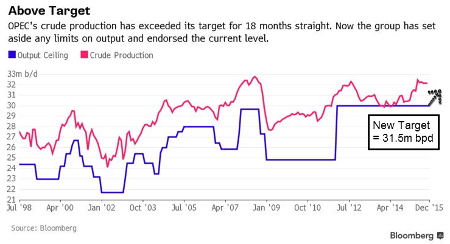
(Bloomberg w/my Updated Production Target)
While the U.S. today is Services centric, the decline in last week’s ISM Manufacturing data should make you take notice…
Today’s report on the ISM Manufacturing report for the month of November was a big disappointment as not only did the headline number miss expectations (48.6 act. vs. 50.5 est.), but it also dropped below 50 (dividing line between expansion and contraction) and fell to its lowest level since June 2009. While it should surprise no one that the manufacturing sector in the U.S. has been struggling and is no longer the behemoth that it once was in the U.S. economy, when you start having to go back to the last recession to find times when any economic indicator was as bad as the current reading, it raises concerns.
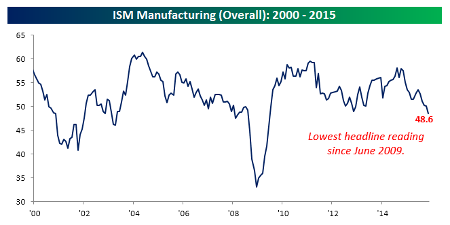
For the week, Tech and Staples continue to lead the Equity sectors. Energy is locking in its ‘Red Lantern’ award for the Tour de Stocks 2016…
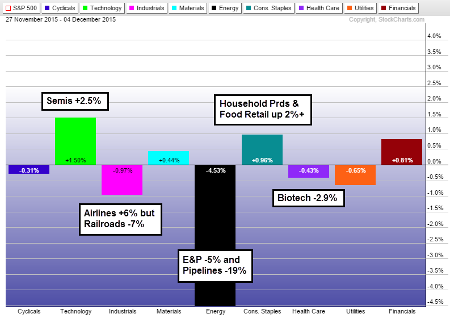
November Mutual Fund flows show continued movement from Active to Passive. Nice to see Alternatives leading share gains in the Active category…
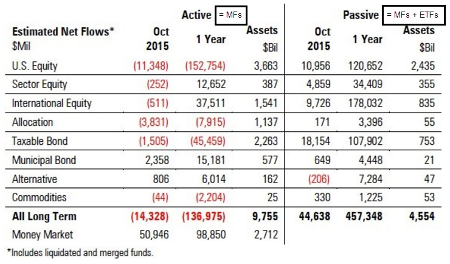
(Morningstar)
Speaking of Active management, last week one of the largest, most successful Hedge Funds decided to return its outside investors money last week…
We would like to thank all of our investors who have supported us over the last 15 years and are pleased that, as we make this decision, all of the current BlueCrest funds are at, or close to, their ‘high water mark’.
Recent developments in the industry, including, among other things, downward pressure on fee levels, the increasing cost of hiring the best portfolio management talent and the difficulty in tailoring investment products to meet the individual needs and constraints of a large number of diverse investors, have all significantly reduced industry profitability and flexibility. These factors have affected BlueCrest along with many other industry participants, and BlueCrest believes that a transition to a Private Investment Partnership model is now appropriate for the business.
Now back to the Junk, LBO paper is building like a rising floodwater. Will the banks be able to sell all that they have promised?
Leveraged-finance bankers are facing a bad hangover after a record year for U.S. mergers and acquisitions. They must find buyers for about $49 billion of acquisition-related leveraged loans, which is the biggest backlog for a December in Standard & Poor’s Capital IQ LCD data going back to 2010. That doesn’t even include the billions of dollars of M&A-related junk bonds that are also in the pipeline. There’s about $200 billion of M&A-related investment-grade debt that needs to be issued based on announced deals, according to Barclays (L:BARC) estimates. That’s also well above average for this time of year.
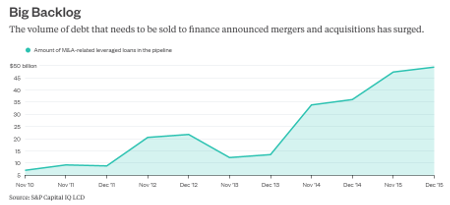
So then another $250b in paper is going to hit these ratings tranches? That is a sizable increase.
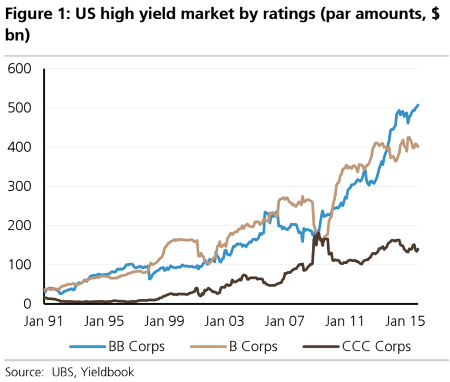
The Wall Street Journal is even giving Front Page recognition to the Junk Bond bubble…
U.S. corporate high-yield bonds are down 2% this year, including interest payments, according to Barclays PLC data. Junk bonds have posted only four annual losses on a total-return basis since 1995.
The declines are worrying Wall Street because junk-market declines have a reputation for foreshadowing economic downturns. Junk bonds are lagging behind U.S. stocks following a debt selloff in the past month. The S&P 500 has returned 3.6% on the year, including dividends.
Adding to the worries are signs that the selling has spread beyond firms hit by the energy bust to encompass much of the lowest-rated debt across the market, potentially snarling some takeovers and making it difficult for all kinds of companies to borrow new funds.
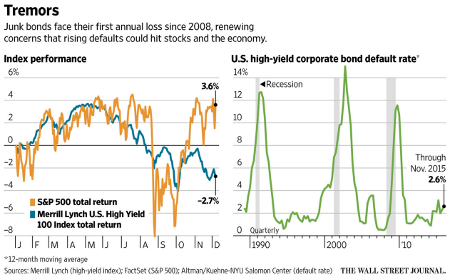
If you are thinking that Junk Bonds are just a minor subset of the Global debt market, then you really need to pay attention. Junk is now 50%!
Just 25 years ago less than a quarter of corporate-bond issuers were ranked speculative, or junk. Now, according to Standard & Poor’s, a rating agency, it is nearly a half. Growth in the market is due to a number of factors. Investors are more willing to buy high-yield debt, thanks to low interest rates; banks are retreating from corporate lending, particularly in Europe; companies are keen to borrow, given the tax benefits. The shift means the average corporate bond is riskier than it used to be. The default rate is rising, but is still low by historic standards: just 2.5% of issuers defaulted in the year to September.

And it is not just U.S. Junk Bonds that are running into default…
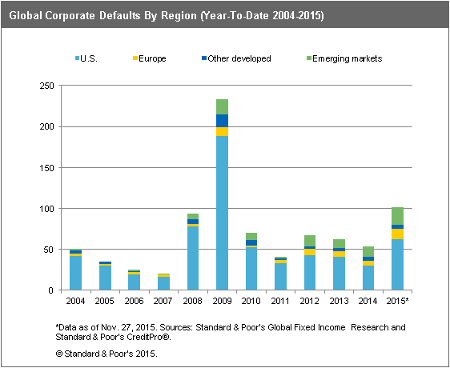
MLPs are a very large instrument for income-seeking investors. Last week Kinder Morgan (N:KMI) showed us what investors think about cuts to their payout ratio…
Houston pipeline giant Kinder Morgan said Friday that it will fight to maintain its investment grade debt rating, even if that means revising dividend or financing plans next year.
The announcement comes after its planned acquisition of a debt-laden affiliate, Natural Gas Pipeline Co. of America, led Moody’s Investors Service to cut Kinder Morgan’s credit outlook from stable to negative. That’s not a credit downgrade in itself, but if one did follow, it would push Kinder Morgan – and its $44 billion in debt – from the lowest tier of investment-grade ratings onto the high-yield or junk-bond markets, where interest rates are higher and capital is harder to raise.
Even Moody’s suggestion that the company might slip was enough to touch off an 18 percent drop in Kinder Morgan’s common share price this week.
It was a tough week for News. This was among the best…
Facebook Inc (O:FB). founder Mark Zuckerberg is giving away his $45 billion fortune in a way that allows him also to invest in companies and influence public policy, while pursuing broader philanthropic aims.
By creating a limited-liability company rather than a foundation, Mr. Zuckerberg and his wife, Priscilla Chan, can support their goals of promoting “personalized learning, curing disease, connecting people and building strong communities,” while sidestepping some limits of tax law and public-disclosure rules.
The move highlights an emerging model of philanthropy that extends beyond grant-making foundations. The fusion of corporate and philanthropic goals and structures “reflects part of the Silicon Valley ethos,” said Amir Pasic, dean of the Lilly Family School of Philanthropy at Indiana University. “There is an impatience with established forms of philanthropy.”
For those of us sending kids off to college, Goldman Sachs (N:GS) gave us some new financial return data to chew on…
“For the typical student the number of years to break even on the cost of college has grown from eight years in 2010 to nine years today. If current cost and wage growth trends persist then students starting college in 2030/2050 will have to wait 11/15 years post college to break even. 18 year olds starting college in 2030 with no scholarship or grants will only start making a positive return when they turn 37,” Goldman’s Hugo Scott-Gall wrote.
A better path to education? Great thoughts from Vinod Khosla…
In the new Liberal Science curriculum I propose, critical thinking would be job one, understanding economics would be important, linguistics would be important, computer science would be absolutely required for everyone, the basic level of the basic sciences would be essential, being able to diagnose literature, not necessarily understand historical literature, to understand what’s relevant about art and what isn’t, to differentiate that an art critic is just an opinion, and what crosses cultures and societies – what are absolutes, what are relatives? – all that would be a part of the curriculum that I design. It would be essential to understand psychology because human behavior and human interaction are important. I’d like to teach people how to understand history but not to spend time getting the knowledge of history which can be done after graduation. I’d like people to read a New York Times article and understand what’s an assumption, what’s an assertion, what are facts, and what are opinions. I’d like people to [know] what is statistically valid and what is not. I could go on, but let me summarize by saying, the old definition of liberal arts is no longer the best use of four years of somebodies education. Some of you will point to very successful people who’ve gone to Yale and done well but you don’t understand statistics. The top 20% of people in any cohort will do well independent of how good or bad their education is, or if they had any. If we want to maximize the potential of the other 80%, then we need a new Liberal Sciences curriculum.
Given the results of my heart CAT scan last week, sign me up for another 50 Star Wars…
The picture that the Lucasfilm faithful relentlessly call A New Hope but everyone else calls Star Wars came out in 1977. It and its sequels (and TV movies and cartoons and toys and bedsheets) burrowed deep into popular culture. And if the people at the Walt Disney Company (N:DIS), which bought Lucasfilm for $4 billion in 2012, have anything to say about it, the past four decades of Star Wars were merely prologue. They are making more. A lot more. The company intends to put out a new Star Wars movie every year for as long as people will buy tickets. Let me put it another way: If everything works out for Disney, and if you are (like me) old enough to have been conscious for the first Star Wars film, you will probably not live to see the last one. It’s the forever franchise.
The information presented here is for informational purposes only, and this document is not to be construed as an offer to sell, or the solicitation of an offer to buy, securities. Some investments are not suitable for all investors, and there can be no assurance that any investment strategy will be successful. The hyperlinks included in this message provide direct access to other Internet resources, including Web sites. While we believe this information to be from reliable sources, 361 Capital is not responsible for the accuracy or content of information contained in these sites. Although we make every effort to ensure these links are accurate, up to date and relevant, we cannot take responsibility for pages maintained by external providers. The views expressed by these external providers on their own Web pages or on external sites they link to are not necessarily those of 361 Capital.

